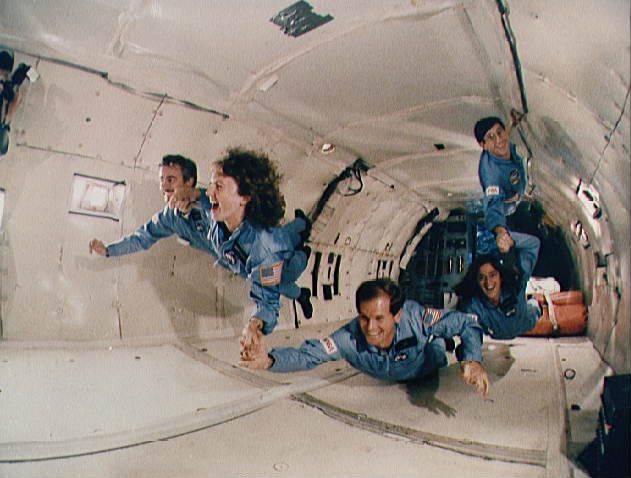
“With the election three months away,” the author writes, “the president and his advisors saw a chance to promote the space program and win teachers’ votes in one stroke.” The administration had previously cut funding to the National Education Association, leaving the group to denounce Reagan as “America’s Scrooge on education.”Ħ After a few launch cancelations, the Challenger finally lifted off in January 1986. The announcement sounded pure, but the program was really a gambit to bolster the president’s reelection chances. “Today,” President Ronald Reagan said, “I’m directing NASA to begin a search to choose as the first citizen passenger in the history of our space program one of America’s finest - a teacher.” Then, in August 1984, McAuliffe saw a headline in the local paper reading, “Reagan Wants Teacher in Space.” She occasionally had students dress in period costumes. She would bring her guitar to class and strum ’60s protest songs. She was an engaging and well-liked teacher. In 1983, she landed her “dream job,” teaching social studies at Concord High School. She attended Framingham State College, and in 1970, she married her former high school boyfriend Steve McAuliffe. “But she wouldn’t have made much of an astronaut anyway,” Cook writes, “a chubby Girl Scout with no knack for science or math who got sick to her stomach on carnival rides.”

McNair likely struggled in vain to prevent their doom after surviving the initial shuttle explosion. Smith (bottom row, from left), Francis R. She idolized John Kennedy for his push to the moon, and as a seventh-grader in 1961, she watched Alan Shepherd become the first American in space.Ħ Challenger astronauts Ellison Onizuka (top row, from left), Christa McAuliffe, Gregory Jarvis, Judith Resnik, Michael J. Growing up in Framingham, Mass., young Christa Corrigan was always fascinated by space. Instead, she ended up as arguably the most well-known name in America’s worst space-related tragedy. She was meant to be the first civilian in space, a fearless woman who set out to prove that “teachers have the right stuff, too,” as one of McAuliffe’s friends put it in the book. McAuliffe, 37, was a Concord, NH, social studies teacher who had won NASA’s Teacher in Space contest and earned a spot on the Jan. 28, 1986, mission as a payload specialist. The brave crew members - Smith, Dick Scobee, Ronald McNair, Ellison Onizuka, Judith Resnik, Gregory Jarvis and Christa McAuliffe - survived the initial disaster and “were conscious, at least at first, and fully aware that something was wrong,” author Kevin Cook writes in the new book “ The Burning Blue: The Untold Story of Christa McAuliffe and NASA’s Challenger” (Henry Holt and Co.), out now. It was ejected in the explosion, and remained intact. Inside Houston’s Mission Control and Florida’s Launch Control centers, rows of S’s lined computer screens, indicating “static.” All audio and communication from the shuttle had been lost.īut the capsule the crew was sitting inside did not explode.

A little-known Air Force official whose title was range safety officer quickly hit a self-destruct button, causing the boosters to explode and fall into the sea rather than on any populated areas. The booster rockets separated, and kept blasting upward on diverging paths.

The tank quickly ruptured, igniting the hydrogen fuel and causing a massive, Hindenburg-like explosion.Ħ McAuliffe was selected out of 11,000 applicants partly because of her ease on camera. The breach allowed a few grams of superheated fuel to burn through.Īt one minute and 12 seconds after liftoff, the small flame grew, taking only three seconds to penetrate the fuel tank’s aluminum skin. The rings failed to expand fully in the cold, leaving a gap of less than a millimeter between booster sections. It was leaking fuel.Īs was later learned, the cold of the Florida morning had stiffened the rubber O-rings that held the booster sections together, containing the explosive fuel inside.

Sitting on the right side of the flight deck, Smith looked out his window and likely saw a flash of vapor or a fire.ĭown on the ground at Mission Control, a computer screen indicated falling pressure in the right booster rocket. The Space Shuttle Challenger was hurtling through the air at twice the speed of sound when pilot Michael Smith noticed something alarming. ‘Challenger: The Final Flight’ trailer explores 1986 tragedyįirst of Christa McAuliffe’s lost lessons released from space Piece of Challenger space shuttle found nearly 37 years after deadly explosion Ex-astronaut says ‘toxic’ NASA hasn’t learned from costly fatal mistakes


 0 kommentar(er)
0 kommentar(er)
